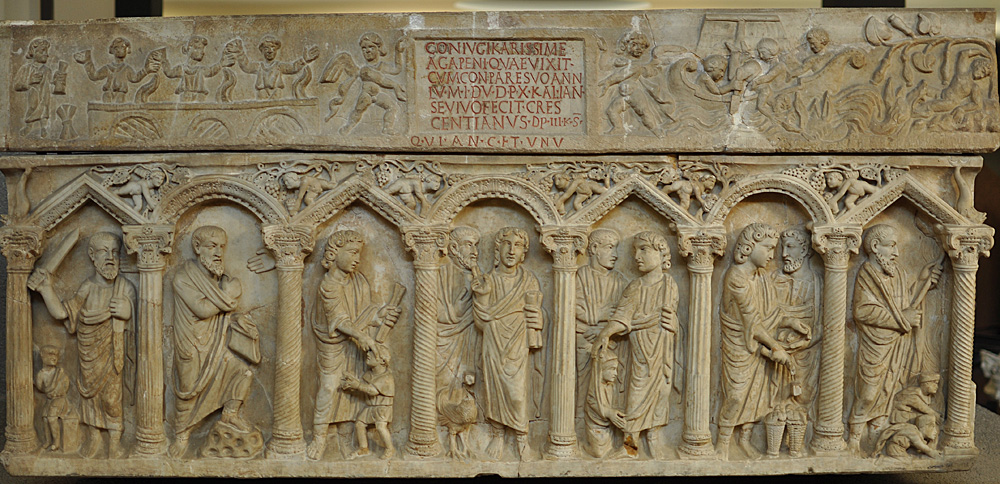Late 4th century
Stone
Museo Pio Cristiano, The Vatican, inventory 31489
THE FRONT OF THE CASE
The central position of the Peter-Jesus-Rooster scene and the emphasis on faith, forgiveness, and salvation in the other scenes strongly supports Sgarlata's suggestion (127) that images like this represent Jesus' forgiveness of Peter in John 21:15-17, not his prediction of the denial for which Peter will need forgiveness (Matthew 26:31-35, Mark 14:27-31, Luke 22:31-34, John 13:36-38). The rooster would then represent Peter's sin of denying Jesus three times on the night of his arrest, and Jesus' two-finger blessing gesture would betoken the forgiveness. It is most significant that Jesus looks not at Peter with his gesture of forgiveness, but at the person viewing the image.
On the two sides of this central exposition of forgiveness are balanced pairs of scenes that deepen the theme. Directly left and right are the cures of the blind man (Matthew 9:29, Matthew 20:34, Mark 8:23, John 9) and the woman with the flow of blood (Matthew 9:20-22, Mark 5:25-34, Luke 8:43-48). As the account of the blind man comes to a close in John 9, Jesus asks him if he believes in the Son of Man, and he answers "I believe, Lord" and falls down to worship him. Faith is also important in the woman's cure: Jesus says to her, "Daughter, your faith has saved you."
The two scenes on the left also form an important pair with the two on the right. On the left man is under the Old Law; on the right, under the New.
The first of the two on the left has the interrupted sacrifice of Isaac. We see God's hand reaching from behind the column to keep Abraham from slaying Isaac, who is already bound before the flaming altar. The first of the two on the right has the multiplication of the loaves and fishes: two baskets of loaves at Jesus' feet, and two fishes in the hands of the apostle to the right. Traditionally this miracle is taken as a sign of the Eucharist; indeed that is how Jesus himself interprets the bread in John 6:22-35,47-59. It can be no coincidence, therefore, that each loaf in the baskets is marked with a cross, for the Eucharist is the memorial of the sacrifice of Christ on the Cross.
In the second of the two scenes on the left God gives Moses the Law on Mount Sinai. This corresponds to the second scene on the right, the miracle by which St. Peter called forth water from the rock wall of his prison cell so he could fulfil his jailers' request for baptism, the sacrament by which the faithful leave the Law and accept salvation by faith in Christ. In the image Peter strikes the rock with a rod while the jailers, dressed as contemporary soldiers, symbolically drink from it. In the same way Moses had provided water for his people by striking the rock at Massah and Meribah (Exodus 17:1-7).
THE LID
On the left of the central inscription are the three Jewish youths in the fiery furnace (Daniel 2). The man on the left may be the one Nebuchadnezzar sees accompanying the youths in the furnace, or it could be Nebuchadnezzar himself. That the person has authority, whether angelic or kingly, is signified by the scroll in his hand.
On the right of the inscription is the story of Jonah. First we see him thrown into the maw of the sea monster by the men on the ship. The ship's mast has a T shape. This is unlikely on any real ship, but it has typological significance, for according to Matthew 12:40 Jonah is a figure of Christ, who spent three days in the monster just as Christ will lie three days "in the heart of the earth." Next we see the fish release Jonah on the shore, where he sleeps under the cooling shade of the gourd tree (Jonah 2:11, 4:6).
The main inscription in the middle of the lid reads CONIUGI KARISSIME AGAPENI QUAE VIXIT CUM CONPARE SUO ANNOS LV MENSEM I DIES V DEPOSITA X KALENDIS IANUARIIS, "For the dearest wife Agape, who lived with her husband 55 years 1 month and 5 days, laid to rest on the 10th kalends of January [December 23], Crescentianus made this when he was alive." After this, squeezed in using smaller letters, is DP IIII K S¯, which seems to record the later burial (dp for depositus, "laid to rest") of Crescentianus on the 4th kalends of September (August 29).
THE LEFT AND RIGHT ENDS OF THE SARCOPHAGUS CASE
For the left end of the sarcophagus (Adam, Eve, and the Serpent), follow this link. For the right end (a larger image of the Fiery Furnace), follow this link.
View this image in full resolution.
Read more about the three Jewish youths, Jonah, Abraham, Moses, the miracles of Jesus, and St. Peter.
Photographed at the museum by Richard Stracke, shared under Attribution-NonCommercial-ShareAlike license.
